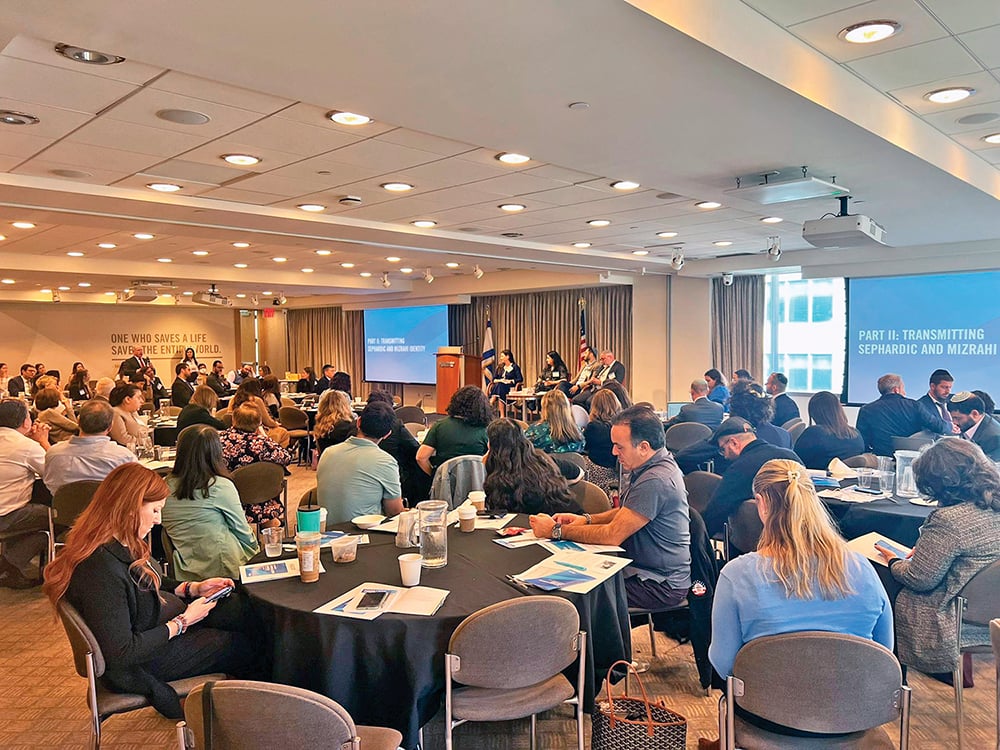
On Thursday, Nov. 7, at the UJA-Federation of New York offices in Manhattan, the seventh floor was abuzz. Community leaders, organizational heads and educators alike were gathered together for the inaugural Sephardic and Mizrahi Symposium, a day filled with engaging research and panel discussions on Sephardic Jewish life. The symposium was centered around a 2023 community study exploring Sephardic and Mizrahi demographics of the region and their respective cultures, practices and identities—and subsequently, what the Jewish community at large could do to better serve them.
“For the past three years, UJA has been doing internal strategic work to lift up the Sephardic and Mizrahi communities,” explained Rina Cohen, UJA-Federation’s lead on the Sephardic and Mizrahi Initiative and the organizer of the symposium. “We had a think tank with leaders from a variety of communities—Iraqi, Persian, Lebanese, Bukharian and so many others—and they wrote a memo to UJA with recommendations on what areas we needed to work on. When it came time for the next step, I knew we needed to encourage other organizations to learn with us … and that’s how we got to this symposium.”
It was important to the event’s organizers that the day’s discussions begin at the heart: the research conducted on Sephardic and Mizrahi Jewish communities, both nationally and in New York. Dr. Mijal Bitton, research director at NYU, began the first part of the symposium with an in-depth exploration of broader trends affecting the community, specifically from a national study commissioned by the Jewish Indigenous to the Middle East and North Africa (JIMENA) organization. Jacob Brzowsky of UJA-Federation then took a deeper dive into the organization’s community study, which looked at the needs of the community as well as their experiences.
“So much of Jewish leadership wants to help the Sephardic communities, but they’re not armed with the data to understand what the needs are, and that’s why it was so important for us to present our research and findings with these presentations,” said Cohen, noting that she has a similar experience in her role in grant work, which requires an in-depth understanding of the population seeking funding. “We can’t address the issues unless we know what the issues are.”
Cohen continued that while the symposium is centered around the data, “the data is just one piece.” She explained that because the Jewish communal world is so collaborative, the data is meant to be a conversation starter—so the symposium should be structured around opening up those conversations. “We want everyone to see the data and be able to react to it and talk about it.”
That’s why, after some table discussions on the research presentations, the day continued with two panels: the first, on transmitting identity in the Sephardic and Mizrahi communities, and the second, on how to meet the communities where they are and address their needs in a sensitive and nuanced way. Throughout both panel discussions, lay leaders and community educators popped up with intriguing questions: How do we include Sephardic students more at Ashkenazi schools? How do we create incentives for young members of the community to continue their strong connections with Judaism at large? How do we address unhelpful stereotypes? How do we build successful partnerships between Sephardic and Ashkenazi organizations?
While panelists gave thoughtful answers to each of the participants’ questions, it was clear that maybe not every question would receive an answer, and perhaps required a more open-ended conversation. During each break at the symposium, the halls filled with attendees eager to learn from each other and inspire one another to try new methods of engagement within their own spheres. “We designed for this,” Cohen noted, adding that the organizers even put thought into the atmosphere: Mizrahi-style music played from overhead speakers while participants noshed on Middle Eastern delicacies.
In an email to UJA-Federation of New York CEO Eric Goldstein, Cohen wrote exactly what she hoped would come of the inaugural symposium. “We hope the attendees walk away with a deeper understanding and appreciation of the unique experiences, contributions and needs of Sephardic and Mizrahi Jews, recognizing the importance of Sephardic and Mizrahi Jews in the broader Jewish landscape. We want participants to lead with concrete ideas, new partnerships and an inspiration to further incorporate Sephardic and Mizrahi culture and needs into their work … our goal is to help them think expansively about how they can support these communities as well.”
Ruben Shimonov of the American Sephardi Federation (ASF) closed the day’s events with a session on the celebration of Sephardic and Mizrahi communities, including a notable explanation on designating November as Sephardic and Mizrahi Heritage Month. According to the ASF, Israel commemorates and recognizes the mass expulsions of Jews from countries throughout the MENA region on November 30—and as such, it was only fitting to make the entire month “a time to celebrate and elevate the vibrant histories, experiences, heritage and resilience of Mizrahi and Sephardic Jews.”
While Cohen was unsure whether the Sephardic and Mizrahi Symposium would be an annual event for UJA, she was certain about one important goal: that UJA-Federation will keep up its work on creating effective strategy and continuing to support Sephardic and Mizrahi leadership to meet the communities’ needs. “There’s a vision for the future.”
Channa Fischer is digital editor of The Jewish Link and the resident 20-something in the office. She resides in Washington Heights.










